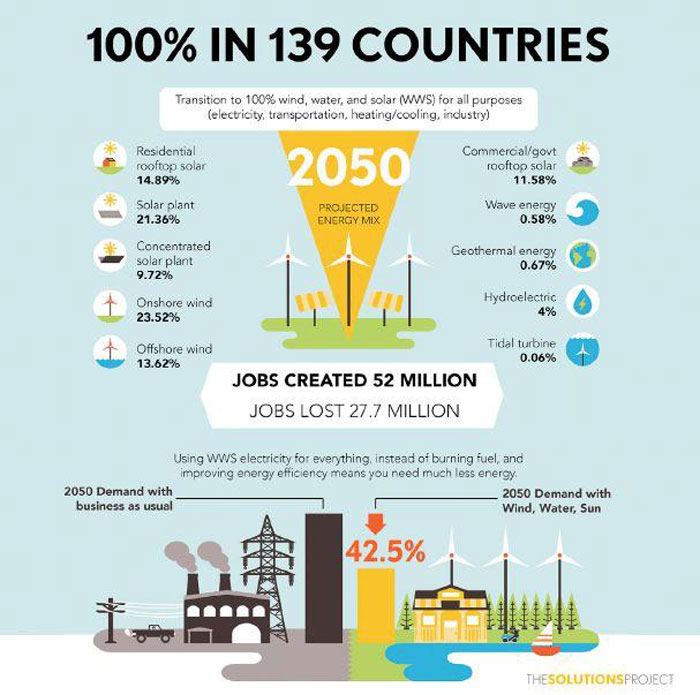Almost three quarters of the world's countries could be powered entirely by renewable energy sources by 2050 – if we want it badly enough, that is.
That's according to an ambitious new 2050 roadmap that calculates a move to an emissions-free future would create millions of jobs, cut trillions in health and climate costs, and help save the planet from global warming.
The estimates, produced by a team of almost 30 scientists, are based on an assessment of the capabilities of 139 countries to transition to 100 percent wind, water, and solar power in the next three and a bit decades.
While such a far-reaching overhaul of existing energy infrastructure goes beyond what the UN's Paris climate agreement (COP21) actually calls for, the researchers say there are compelling reasons for going all in sooner rather than later.
"Our findings suggest that the benefits are so great that we should accelerate the transition to wind, water, and solar, as fast as possible," says one of the team, Mark Delucchi from the University of California, Berkeley, "by retiring fossil-fuel systems early wherever we can."
 The Solutions Project
The Solutions Project
That's because doing so wouldn't just create new jobs in renewables – a net increase of more than 24 million full-time positions is anticipated – it would also make us healthier sooner, with less fossil fuel emissions polluting the atmosphere.
The team says that reduction alone could cut deaths due to air pollution by as much as 4.6 million premature fatalities annually.
But perhaps even more importantly in the long run, making the switch could lock in COP21's goal of keeping the rise in global temperatures to less than 1.5 degrees Celsius above pre-industrial levels.
The research, which in an earlier form was initially presented to world leaders at COP21 in 2015, builds upon a previous US-only roadmap that showed how the 50 US states could make the same kind of renewables transition by 2050.
Both studies were spearheaded by Stanford University's Mark Z. Jacobson – a co-founder of US non-profit The Solutions Project.
"What I find most exciting about the results of this study is that every country that we examined has sufficient resources to power itself," he told Charles Q. Choi at IEEE Spectrum.
"[A]lthough in the case of a couple of tiny countries with very high populations, this might require either importing energy from their neighbour or using an unusually high amount of offshore energy."
That's because larger countries with more landmass respective to the size of their populations enjoy greater flexibility in finding appropriate sites for solar, wind, and hydropower facilities.
While the 139-country roadmap has been a massive undertaking, the team don't intend to stop there.
"We are next developing roadmaps for individual cities to go to 100 percent clean, renewable energy," Jacobson said.
While thousands of the world's cities are already doing an amazing job of independently crushing their carbon emission targets, more localised and granular roadmaps could only help the world to go emissions-free.
As awesome as the rapid uptake of renewables has been in recent times, from where we stand right now we've still got a long way to go to get to 100 percent – but we've got a roadmap, people, and we know which way to head.
